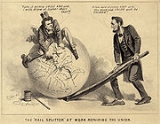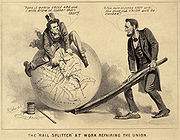
Editorial cartoon
Encyclopedia

They typically combine artistic skill, hyperbole
Hyperbole
Hyperbole is the use of exaggeration as a rhetorical device or figure of speech. It may be used to evoke strong feelings or to create a strong impression, but is not meant to be taken literally....
and biting humour
Humour
Humour or humor is the tendency of particular cognitive experiences to provoke laughter and provide amusement...
in order to question authority
Authority
The word Authority is derived mainly from the Latin word auctoritas, meaning invention, advice, opinion, influence, or command. In English, the word 'authority' can be used to mean power given by the state or by academic knowledge of an area .-Authority in Philosophy:In...
and draw attention to corruption
Corruption
Corruption usually refers to spiritual or moral impurity.Corruption may also refer to:* Corruption , an American crime film* Corruption , a British horror film...
and other social ills.
History
Notable editorial cartoons include Benjamin FranklinBenjamin Franklin
Dr. Benjamin Franklin was one of the Founding Fathers of the United States. A noted polymath, Franklin was a leading author, printer, political theorist, politician, postmaster, scientist, musician, inventor, satirist, civic activist, statesman, and diplomat...
's "Join, or Die
Join, Or Die
Join or Die is a 2003 album by Amen. It was the first album published by the Refuse Music label and was limited to 2000 copies with the first 1000 copies hand numbered by Casey Chaos in his blood...
" (1754), on the need for unity in the American colonies, "The Thinkers Club
The Thinkers Club
The Thinkers Club was a cartoon based on a fictitious group of professors and scholars which was popularized throughout the German Confederation in 1819....
" (1819), a response to the surveillance and censorship of universities in Germany under the Carlsbad Decrees
Carlsbad Decrees
The Carlsbad Decrees were a set of reactionary restrictions introduced in the states of the German Confederation by resolution of the Bundesversammlung on 20 September 1819 after a conference held in the spa town of Carlsbad, Bohemia...
, and E. H. Shepard
E. H. Shepard
Ernest Howard Shepard was an English artist and book illustrator. He was known especially for his human-like animals in illustrations for The Wind in the Willows by Kenneth Grahame and Winnie-the-Pooh by A. A. Milne....
's "The Goose-Step
The Goose-Step
The Goose-Step is a political cartoon by E. H. Shepard, drawn in 1936.It shows an armed goose marching down a road. There is a swastika on its chest, and it is stepping on a torn Locarno Pact. The Goose holds an olive branch in its beak with a label reading "Pax Germanica" attached to it. There are...
" (1936), on the rearmament of Germany under Hitler. "The Goose-Step" is one of a number of notable cartoons first published in the British Punch
Punch (magazine)
Punch, or the London Charivari was a British weekly magazine of humour and satire established in 1841 by Henry Mayhew and engraver Ebenezer Landells. Historically, it was most influential in the 1840s and 50s, when it helped to coin the term "cartoon" in its modern sense as a humorous illustration...
magazine.
Institutions which archive and document editorial cartoons include the Center for the Study of Political Graphics
Center for the Study of Political Graphics
The Center for the Study of Political Graphics is a United States non-profit, educational and research archive that collects, preserves, documents, and circulates domestic and international political posters relating to historical and contemporary movements for social change...
in the United States, and the British Cartoon Archive
British Cartoon Archive
The British Cartoon Archive is a department of the University of Kent, at Canterbury in the United Kingdom, and holds the national collection of political and social-comment cartoons from British newspapers and magazines...
in the United Kingdom.
Editorial cartoons and editorial cartoonist
Editorial cartoonist
An editorial cartoonist, also known as a political cartoonist, is an artist who draws editorial cartoons that contain some level of political or social commentary....
s are recognised by a number of awards, for example the Pulitzer Prize for Editorial Cartooning
Pulitzer Prize for Editorial Cartooning
The Pulitzer Prize for Editorial Cartooning has been awarded since 1922 for a distinguished cartoon or portfolio of cartoons published during the year, characterized by originality, editorial effectiveness, quality of drawing, and pictorial effect...
(for US cartoonists, since 1922) and the British Press Awards
British Press Awards
The British Press Awards is an annual ceremony that celebrates the best of British journalism. Established in the 1970s, honours are voted on by a panel of journalists and newspaper executives...
' "Cartoonist of the Year".
Modern political cartoons
Political cartoons can usually be found on the editorial page of most newspaperNewspaper
A newspaper is a scheduled publication containing news of current events, informative articles, diverse features and advertising. It usually is printed on relatively inexpensive, low-grade paper such as newsprint. By 2007, there were 6580 daily newspapers in the world selling 395 million copies a...
s, although a few (such as Garry Trudeau
Garry Trudeau
Garretson Beekman "Garry" Trudeau is an American cartoonist, best known for the Doonesbury comic strip.-Background and education:...
's Doonesbury
Doonesbury
Doonesbury is a comic strip by American cartoonist Garry Trudeau, that chronicles the adventures and lives of an array of characters of various ages, professions, and backgrounds, from the President of the United States to the title character, Michael Doonesbury, who has progressed from a college...
) are sometimes found on the regular comic strip
Comic strip
A comic strip is a sequence of drawings arranged in interrelated panels to display brief humor or form a narrative, often serialized, with text in balloons and captions....
page. A good collection of modern editorial cartoons can be found in each issue of magazines like the Humor Times
Humor Times
Humor Times is an American monthly magazine that "reviews the news" using political satire.The publication was founded in Sacramento, California by publisher/editor James Israel, with the premiere issue appearing in April, 1991, originally titled the Comic Press News...
and Funny Times. Recently, many radical or minority issue editorial cartoonists, who would previously have been obscure, have found large audiences on the Internet
Internet
The Internet is a global system of interconnected computer networks that use the standard Internet protocol suite to serve billions of users worldwide...
(a medium which also makes it possible to publish animated political cartoons
Animated political cartoons
Animated political cartoons are the evolution of the Editorial cartoon. The animated political cartoons are normally written in Flash.- Emergence :...
). Cartoons can be very diverse, but there is a certain established style among most of them. Most use visual metaphors and caricatures to address complicated political situations, and thus sum up a current event with a humorous or emotional picture. Often, their content includes stereotypical
Stereotype
A stereotype is a popular belief about specific social groups or types of individuals. The concepts of "stereotype" and "prejudice" are often confused with many other different meanings...
, bias
Bias
Bias is an inclination to present or hold a partial perspective at the expense of alternatives. Bias can come in many forms.-In judgement and decision making:...
ed and/or demonizing
Demonization
Demonization is the reinterpretation of polytheistic deities as evil, lying demons by other religions, generally monotheistic and henotheistic ones...
portrayals of people and events.
In modern political cartooning two styles have begun to emerge. The traditional style, involving visual metaphors and symbols like Uncle Sam
Uncle Sam
Uncle Sam is a common national personification of the American government originally used during the War of 1812. He is depicted as a stern elderly man with white hair and a goatee beard...
, the Democratic donkey and the Republican elephant, and labels is described as the "nast-y" style (named after Thomas Nast
Thomas Nast
Thomas Nast was a German-born American caricaturist and editorial cartoonist who is considered to be the "Father of the American Cartoon". He was the scourge of Boss Tweed and the Tammany Hall machine...
), and the more text-heavy "altie" style that tells a linear story, usually in comic strip format. Although their style, technique or viewpoints may differ, editorial cartoonists draw attention to important social and political issues. Political cartoons are an effective way for artists to express their thoughts about the events in a certain period in a comical manner.
Pocket cartoons
A pocket cartoon is a form of editorial cartoon which consists of a topical single-panel single-column drawing. It was introduced by Osbert LancasterOsbert Lancaster
Sir Osbert Lancaster, CBE was an English cartoonist, author, art critic and stage designer, best known to the public at large for his cartoons published in the Daily Express.-Biography:Lancaster was born in London, England...
in 1939 at the Daily Express
Daily Express
The Daily Express switched from broadsheet to tabloid in 1977 and was bought by the construction company Trafalgar House in the same year. Its publishing company, Beaverbrook Newspapers, was renamed Express Newspapers...
. A 2005 obituary by The Guardian
The Guardian
The Guardian, formerly known as The Manchester Guardian , is a British national daily newspaper in the Berliner format...
of its pocket cartoonist David Austin
David Austin (cartoonist)
David Austin was a British cartoonist. He was best known for his pocket cartoons in The Guardian, which he contributed from 1990 to 2005, and for the strip Hom Sap in Private Eye, which began in 1970...
said "Newspaper readers instinctively look to the pocket cartoon to reassure them that the disasters and afflictions besetting them each morning are not final. By taking a sideways look at the news and bringing out the absurd in it, the pocket cartoonist provides, if not exactly a silver lining, then at least a ray of hope."
Controversies
Editorial cartoons sometimes cause controversies. Examples include the Jyllands-Posten Muhammad cartoons controversyJyllands-Posten Muhammad cartoons controversy
The Jyllands-Posten Muhammad cartoons controversy began after 12 editorial cartoons, most of which depicted the Islamic prophet Muhammad, were published in the Danish newspaper Jyllands-Posten on 30 September 2005...
(stemming from the publication of cartoons of Muhammad
Muhammad
Muhammad |ligature]] at U+FDF4 ;Arabic pronunciation varies regionally; the first vowel ranges from ~~; the second and the last vowel: ~~~. There are dialects which have no stress. In Egypt, it is pronounced not in religious contexts...
) and the 2007 Bangladesh cartoon controversy
2007 Bangladesh cartoon controversy
The 2007 Bangladesh cartoon controversy began after an editorial cartoon was published in the 431st edition of Alpin , a featured supplement of the Bangladeshi newspaper Prothom Alo, on 17 September 2007...
.
See also
- Attitude: The New Subversive CartoonistsAttitude: The New Subversive CartoonistsThe Attitude series of books is a series of anthologies of alternative comics, photos and artists' interviews edited by Universal Press Syndicate editorial cartoonist Ted Rall. The books were designed by J. P. Trostle, news editor of EditorialCartoonists.com. Two sequels and three spin-off titles...
- GraphicsGraphicsGraphics are visual presentations on some surface, such as a wall, canvas, computer screen, paper, or stone to brand, inform, illustrate, or entertain. Examples are photographs, drawings, Line Art, graphs, diagrams, typography, numbers, symbols, geometric designs, maps, engineering drawings,or...
- List of editorial cartoonists
External links
- American Association of Editorial Cartoonists Political cartoons by the members of the American Association of Editorial Cartoonists
- About.com: Political Cartoons Comprehensive guide to political editorial cartoons on the Web
- Using editorial cartoons in the classroom Sources, analysis, interpretation (mostly English with some German)
- Gettysburg College Civil War Era Digital Collection Contains over 300 Civil War Era political cartoons
- American Social History Online
- The Role of Puck's Cartoons in Gilded Age Politics from American Studies at the University of Virginia
- CartoonMovement.com: Political Cartoons and Comics Journalism from around the world

